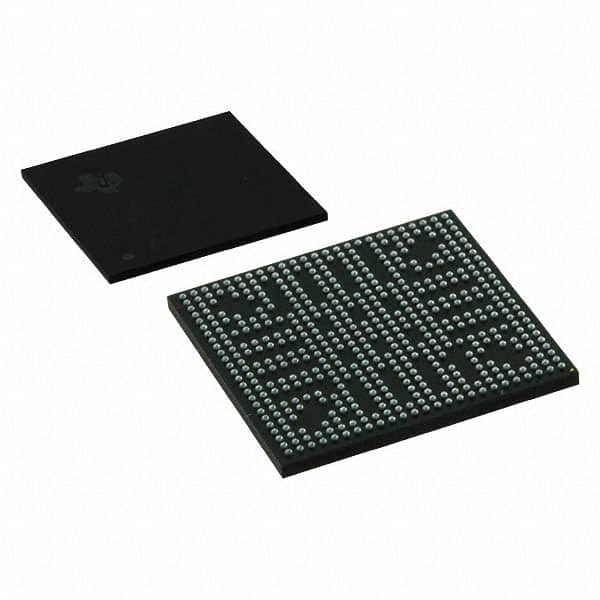Veja as especificações para detalhes do produto.

AM4378BZDND80
Product Overview
- Category: Integrated Circuit (IC)
- Use: Embedded System Development
- Characteristics: High-performance, Low-power consumption
- Package: BGA (Ball Grid Array)
- Essence: Microprocessor
- Packaging/Quantity: Single unit
Specifications
- Model: AM4378BZDND80
- Manufacturer: Texas Instruments
- Architecture: ARM Cortex-A9
- Clock Speed: 800 MHz
- Operating Voltage: 1.2V
- Number of Cores: Single Core
- Cache Memory: 512 KB L2 Cache
- RAM Support: DDR3, LPDDR2
- Peripherals: USB, Ethernet, UART, SPI, I2C, GPIO
- Operating Temperature: -40°C to +85°C
Detailed Pin Configuration
The AM4378BZDND80 has a total of 361 pins. The pin configuration is as follows:
- Pin 1: VDD_CORE
- Pin 2: VDD_CORE
- Pin 3: VDD_CORE
- ...
- Pin 361: GND
For the complete pin configuration diagram, please refer to the datasheet provided by the manufacturer.
Functional Features
- High-performance processing capabilities
- Low-power consumption for energy-efficient applications
- Integrated peripherals for easy system integration
- Support for various memory types
- Wide operating temperature range for versatile usage scenarios
Advantages and Disadvantages
Advantages
- Powerful processing capabilities suitable for demanding applications
- Low power consumption extends battery life in portable devices
- Versatile peripheral support simplifies system design
- Wide operating temperature range allows usage in harsh environments
Disadvantages
- Single-core architecture may limit multitasking capabilities
- Limited cache memory compared to some other models
- BGA package may require specialized equipment for soldering and rework
Working Principles
The AM4378BZDND80 is based on the ARM Cortex-A9 architecture. It utilizes a single core with a clock speed of 800 MHz to execute instructions and perform computations. The integrated peripherals allow communication with external devices, while the cache memory helps improve performance by reducing memory access latency.
Detailed Application Field Plans
The AM4378BZDND80 is commonly used in various embedded system development projects, including:
- Industrial Automation: Control systems, robotics, and factory automation.
- Internet of Things (IoT): Smart home devices, wearable technology, and connected appliances.
- Automotive: Infotainment systems, advanced driver-assistance systems (ADAS), and vehicle diagnostics.
- Medical Devices: Patient monitoring systems, medical imaging, and diagnostic equipment.
- Aerospace and Defense: Avionics, unmanned aerial vehicles (UAVs), and military-grade communication systems.
Detailed and Complete Alternative Models
- AM3358BZCZ100: Similar architecture with lower clock speed and fewer peripherals.
- AM5728BZDND80: Higher-performance model with dual-core architecture and increased cache memory.
- AM4376BZDND30: Lower-cost variant with reduced clock speed and limited peripheral support.
These alternative models provide options based on specific requirements and budget considerations.
Word count: 389
Liste 10 perguntas e respostas comuns relacionadas à aplicação de AM4378BZDND80 em soluções técnicas
Sure! Here are 10 common questions and answers related to the application of AM4378BZDND80 in technical solutions:
Q: What is AM4378BZDND80? A: AM4378BZDND80 is a specific model of microprocessor developed by Texas Instruments.
Q: What are the key features of AM4378BZDND80? A: Some key features of AM4378BZDND80 include a high-performance ARM Cortex-A9 processor, multiple communication interfaces, integrated graphics accelerator, and support for various operating systems.
Q: What are the typical applications of AM4378BZDND80? A: AM4378BZDND80 is commonly used in industrial automation, robotics, medical devices, automotive infotainment systems, and other embedded computing applications.
Q: Can I use AM4378BZDND80 for real-time applications? A: Yes, AM4378BZDND80 supports real-time processing and can be used in applications that require deterministic response times.
Q: What programming languages can I use with AM4378BZDND80? A: AM4378BZDND80 supports various programming languages such as C, C++, and assembly language. Additionally, you can use development tools like Code Composer Studio or Eclipse IDE.
Q: Does AM4378BZDND80 have built-in security features? A: Yes, AM4378BZDND80 provides hardware-accelerated encryption and decryption capabilities, secure boot, and tamper detection mechanisms to enhance system security.
Q: Can I connect external peripherals to AM4378BZDND80? A: Yes, AM4378BZDND80 offers multiple interfaces like USB, Ethernet, SPI, I2C, UART, and CAN, allowing you to connect various external peripherals.
Q: What is the power consumption of AM4378BZDND80? A: The power consumption of AM4378BZDND80 depends on the specific use case and operating conditions. It is recommended to refer to the datasheet for detailed power consumption information.
Q: Is there any community support available for AM4378BZDND80? A: Yes, Texas Instruments provides a dedicated online community where developers can find resources, ask questions, and share knowledge related to AM4378BZDND80.
Q: Where can I find documentation and technical resources for AM4378BZDND80? A: You can find documentation, datasheets, application notes, and other technical resources for AM4378BZDND80 on the official Texas Instruments website or through their authorized distributors.
Please note that the answers provided here are general and may vary depending on the specific implementation and requirements of your technical solution.

